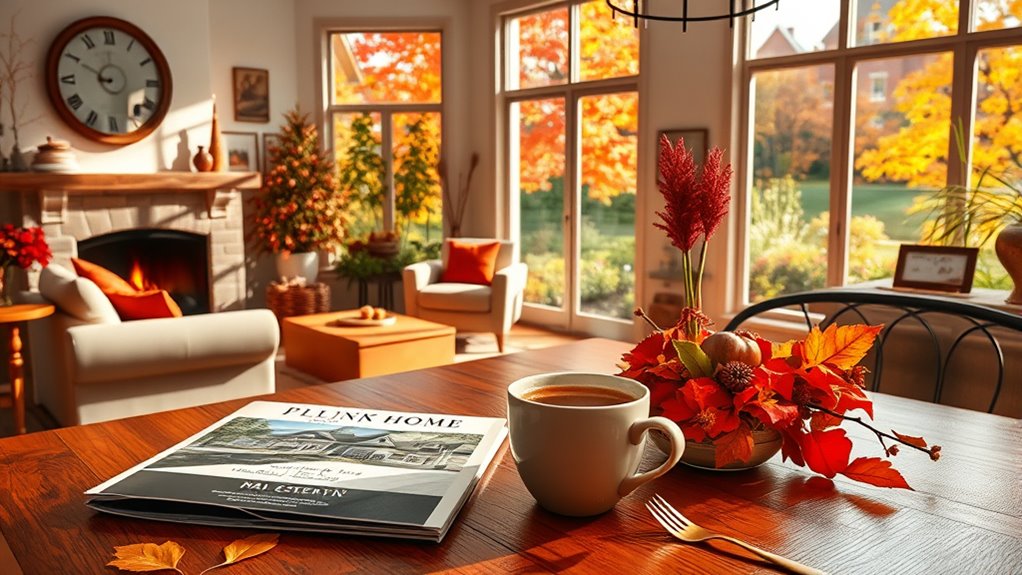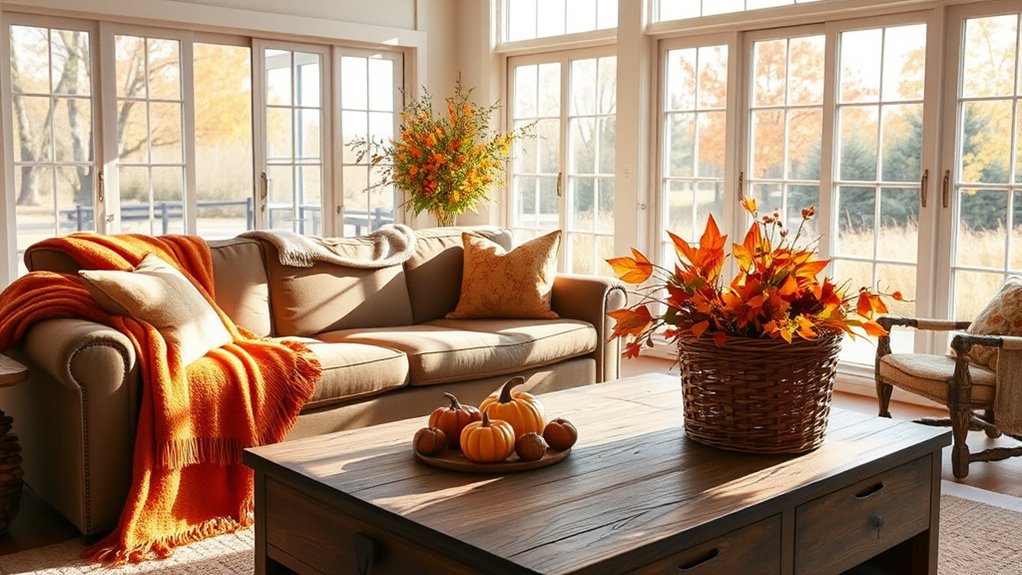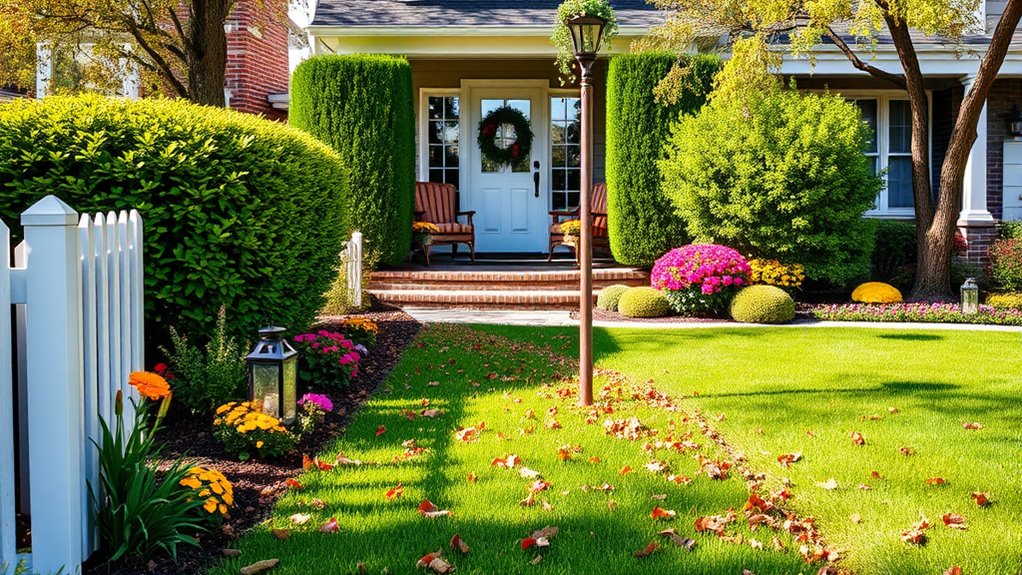To get the most out of seasonal home sales, time your listing to peak months like spring and summer, when demand is higher. Enhance your home’s curb appeal with landscaping and staging, and keep it clean for viewings. Use flexible negotiation strategies to attract buyers and consider regional market trends for pricing. Don’t underestimate the value of DIY projects to boost appeal. There’s more important info you’ll want to know to maximize your sale.
Key Takeaways
- List your home between April and June to benefit from peak seasonal demand and potentially higher sale prices.
- Enhance curb appeal with landscaping and seasonal decor to attract serious buyers during showings.
- Utilize competitive market analysis to set a realistic price based on local market trends and seasonal demand.
- Be flexible in negotiations to accommodate buyers’ requests, which can increase interest in your home.
- Consider DIY projects to improve your home’s value and appearance, yielding a good return on investment.
Understanding Seasonal Trends in Real Estate

Understanding seasonal trends in real estate is essential if you want to maximize your selling potential. The real estate market typically peaks in spring and summer, with buyers actively searching for homes.
Listing your property between April and June can lead to quicker sales and higher home prices—up to 16% more expensive than in winter months.
Listing your home in spring can result in faster sales and prices soaring by as much as 16% compared to winter.
However, don’t overlook fall and winter; while activity slows, serious buyers are still out there, and less competition can make your home stand out.
Remember, regional variations exist, so researching your local market is important.
The Importance of Timing Your Sale

Timing your sale is vital if you want to maximize your home’s potential. Selling during peak seasons, like spring and summer, can greatly impact your results.
Homes typically sell for about 16% more in June compared to winter months. Additionally, the median days on the market drop to just 33 days in June, compared to 49 days in winter.
Listing your property in spring allows you to capitalize on increased buyer activity, with an average of over 16,500 homes sold daily during peak months.
It’s also important to understand local market conditions, as these can vary. Flexibility with your selling timeline can create opportunities, especially for families looking to close before the school year begins.
Preparing Your Home for the Season

To attract buyers during the peak selling season, you’ll want to enhance your home’s curb appeal and stage it effectively.
Start by maintaining your landscaping and decluttering your spaces to create a welcoming atmosphere.
These steps can make a significant difference in how your home is perceived when buyers come calling.
Enhance Curb Appeal
Enhancing your home’s curb appeal is essential, especially when you want to attract potential buyers during peak selling seasons.
Start with well-maintained landscaping; regular grass cutting and vibrant flower planting can make a significant difference. Trimming shrubs and bushes improves accessibility and allows for a clear view of your home, creating inviting first impressions during open houses.
If your grass looks unhealthy, consider adding new sod to foster a welcoming atmosphere. Don’t forget seasonal decorations like potted plants or tasteful holiday adornments to improve appeal without overwhelming the aesthetic.
In winter, keep walkways clear of snow and ice to guarantee safe access for potential buyers, highlighting your home’s best features.
Stage for Seasonal Appeal
Once you’ve improved your home’s curb appeal, the next step is staging for seasonal appeal.
To attract buyers, use seasonal decor that creates a warm, inviting atmosphere. Think soft throw blankets and cozy seating areas to help potential buyers envision their new lives in your home.
Maximize natural light during showings and brighten dark corners with accent lighting to enhance the overall appeal. Keep your home clean and decluttered; a tidy space leaves a positive impression.
You can also consider staging with seasonal elements, like a beautifully set dining table or subtle holiday decorations, to create memorable experiences that resonate with buyers.
Enhancing Curb Appeal

To attract potential buyers, you need to focus on enhancing your home’s curb appeal.
Simple landscaping improvements, like trimming shrubs and planting flowers, can make a huge difference in how your property is perceived.
Regular exterior maintenance, such as power-washing surfaces, guarantees your home stands out in a competitive market.
Landscaping Improvements
If you want to attract potential buyers, investing in landscaping improvements is essential for boosting your home’s curb appeal.
Well-maintained landscaping can help your property sell faster, often for 5-10% more than similar homes without appealing exteriors. During peak selling seasons like spring and summer, regular grass cutting, flower planting, and shrub trimming keep your lawn looking inviting.
Consider investing in new sod if your grass appears unhealthy or patchy; it makes a strong first impression. Seasonal landscaping improvements, such as adding blooming flowers and maintaining green foliage, can make your home stand out during open houses, especially when buyer demand is high.
Prioritizing curb appeal is vital for attracting interest in today’s competitive market.
Exterior Maintenance Tips
Maintaining your home’s exterior is essential for enhancing curb appeal, especially when you’re looking to attract buyers.
Here are some exterior maintenance tips to boost your home’s appeal during the selling season:
- Landscaping: Regularly cut grass and plant flowers to keep your yard vibrant and inviting.
- Trim Shrubs: Maintain accessibility and visibility by trimming back overgrown bushes.
- Lawn Care: If your grass looks unhealthy, consider laying new sod for a lush appearance.
- Clean Up: Power-wash driveways, clean gutters, and add seasonal decorations like potted plants or outdoor lighting to create an inviting atmosphere.
Staging Your Home Effectively

Staging your home effectively can make all the difference when selling, especially during peak seasons. Well-staged homes can sell up to 20% faster, so focus on decluttering and organizing your spaces.
Remove personal items and excess furniture to create an illusion of more space, allowing potential buyers to visualize themselves in your home. Keep counters clear and arrange furniture to enhance functionality, maximizing each room’s appeal during showings.
Consider seasonal staging by adding cozy throws in winter or fresh flowers in spring to resonate with buyers emotionally.
If you’re unsure, hiring a professional stager can greatly boost buyer appeal, potentially increasing your sale price by 6-10%.
Don’t underestimate the power of effective staging!
Pricing Strategies for Seasonal Sales

When it comes to pricing your home for a seasonal sale, understanding the local market is essential.
You’ll want to adapt your pricing strategy based on seasonal demand and nearby listings to stay competitive.
Competitive Market Analysis
How can you effectively price your home for a seasonal sale? Start with a competitive market analysis to assess similar homes sold in your area. This helps you establish a realistic price point based on current market conditions.
Use these strategies to refine your pricing strategy:
- Assess Seasonal Demand: Understand that homes listed in spring usually sell faster and at higher prices.
- Monitor Inventory Levels: A low inventory during peak seasons can justify a higher asking price.
- Evaluate Median Days on the Market: Homes may average 29 days in June but extend to 41 days by October.
- Be Flexible: If offers aren’t coming in, be prepared to adjust your list price quickly based on market shifts.
Seasonal Pricing Adjustments
After establishing a competitive price through market analysis, adjusting your strategy for seasonal fluctuations becomes important.
During peak selling seasons, like spring and summer, homes are often priced 16% higher in June compared to winter months. To capitalize on increased buyer demand, you’ll need to implement strategic pricing. As competition rises, guarantee your listing price stands out against similar properties in your neighborhood.
In slower seasons, like fall and winter, consider lowering your asking price, as average home prices typically dip, prompting buyers to seek better deals.
Understanding local market dynamics is essential; regional variations can greatly impact how you price your home throughout the year, making seasonal pricing adjustments critical for success.
Marketing Your Home During Peak Seasons

Ready to make the most of your home sale? Marketing your home during peak seasons can lead to faster sales and higher prices.
Here are four strategies to attract buyers looking for their dream home:
- Enhance Curb Appeal: Use blooming flowers and landscaping to create a welcoming atmosphere.
- Stage Outdoor Spaces: Highlight patios and gardens to showcase enjoyable outdoor living.
- Leverage Extended Daylight: Take advantage of longer days to offer flexible viewing times, making it easier for buyers to visit.
- Timing is Key: List your home in spring or summer for maximum visibility, as homes sold in June often fetch 16% more than those sold in winter.
Flexibility in Negotiations

While guiding through the home selling process, being flexible in negotiations can considerably impact your success. In a competitive market, adjusting your approach can attract more buyers and expedite your sale.
For instance, consider accommodating requests for quick or delayed closing dates; this shows buyers you’re willing to work with their timelines. You might also enhance your home’s appeal by negotiating on price or offering concessions, making it more attractive.
Additionally, being open to reasonable repair requests or feedback can smooth out the transaction. By embracing flexibility in negotiations, you not only meet buyer needs but also improve your chances of a successful sale, ensuring a win-win situation for both parties.
Navigating Regional Market Variations

Understanding the nuances of your local market is key to maximizing your home sale during seasonal fluctuations. Regional variations can greatly affect local market conditions and home sales.
To navigate these dynamics effectively, consider the following:
- Research seasonal trends: Know which months see the highest activity in your area.
- Analyze competition: Understand how many homes are on the market during peak and off-peak seasons.
- Evaluate buyer demographics: Identify if your market is influenced by second-home buyers or primary residents.
- Adjust pricing strategies: Be flexible with your pricing based on seasonal demand and local conditions.
DIY Projects to Boost Home Value

If you want to maximize your home’s value before a sale, tackling some DIY projects can make a significant difference. Simple upgrades can enhance curb appeal and property value, making your home more attractive to buyers. Consider these impactful DIY projects:
| Project | Benefits | Estimated ROI |
|---|---|---|
| Repainting Walls | Freshens appearance | Up to 107% on selling |
| Power-Washing Exteriors | Improves curb appeal | Reduces market days |
| Landscaping Improvements | Boosts property value | 5-10% increase |
Installing new light fixtures or updating cabinet hardware can modernize your home. Don’t forget regular maintenance like cleaning gutters, showing buyers your home is well cared for. These DIY projects will help when selling!
Frequently Asked Questions
What Is the 30/30/3 Rule for Home Buying?
The 30/30/3 rule for home buying is a guideline to help you maintain financial stability.
You should aim to spend no more than 30% of your gross monthly income on housing costs.
It’s also important to save at least 30% of the home’s price for a down payment, which helps you avoid PMI.
Finally, consider homes priced at no more than three times your annual income to keep your budget in check.
How Can I Maximize My Profit When Selling My House?
To maximize your profit when selling your house, focus on key strategies.
First, price your home competitively by researching local listings.
Next, invest in professional staging to enhance its appeal.
Don’t forget to boost curb appeal with well-maintained landscaping, creating a great first impression.
Finally, be flexible with your closing timeline to accommodate potential buyers, which can lead to smoother transactions and better offers.
Take these steps, and you’ll see increased profits.
What Season Do Houses Sell the Most?
Houses sell the most during spring, particularly from March to May.
This peak season sees increased buyer activity and faster sales, as favorable weather encourages more people to house-hunt. In fact, homes typically sell quicker and at higher prices during this time.
If you’re looking to buy or sell, targeting these months can maximize your chances of success.
Just remember, summer’s also busy, but demand can drive prices up considerably.
What Is the Busiest Month for House Sales?
If you think about it, selling a house in June is like trying to catch lightning in a bottle.
June’s the busiest month for house sales, with a staggering 16,530 existing homes selling daily.
You’ll notice that homes sell faster, averaging just 33 days on the market.
Plus, prices tend to be about 16% higher than in winter months, thanks to families enthusiastic to move before the school year kicks off.
Conclusion
By understanding seasonal trends, timing your sale, and preparing your home effectively, you can maximize your chances of success. Enhance your curb appeal, stage your home to attract buyers, and market during peak seasons to stand out. Stay flexible in negotiations and adapt to regional market variations. With a few DIY projects to boost value, you can turn your home into a buyer’s dream. Embrace the season, seize the moment, and watch your home shine!









